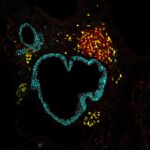
Publication: Molecular and Functional Characterization of Lymphoid Progenitor Subsets Reveals a Bipartite Architecture of Human Lymphopoiesis.
Publié dans: Immunity 2017 Oct; 47(4): 680-696.e8
Auteurs: Alhaj Hussen K, Vu Manh TP, Guimiot F, Nelson E, Chabaane E, Delord M, Barbier M, Berthault C, Dulphy N, Alberdi AJ, Burlen-Defranoux O, Socié G, Bories JC, Larghero J, Vanneaux V, Verhoeyen E, Wirth T, Dalod M, Gluckman JC, Cumano A, Canque B
Résumé
The classical model of hematopoiesis established in the mouse postulates that lymphoid cells originate from a founder population of common lymphoid progenitors. Here, using a modeling approach in humanized mice, we showed that human lymphoid development stemmed from distinct populations of CD127- and CD127+ early lymphoid progenitors (ELPs). Combining molecular analyses with in vitro and in vivo functional assays, we demonstrated that CD127- and CD127+ ELPs emerged independently from lympho-mono-dendritic progenitors, responded differently to Notch1 signals, underwent divergent modes of lineage restriction, and displayed both common and specific differentiation potentials. Whereas CD127- ELPs comprised precursors of T cells, marginal zone B cells, and natural killer (NK) and innate lymphoid cells (ILCs), CD127+ ELPs supported production of all NK cell, ILC, and B cell populations but lacked T potential. On the basis of these results, we propose a “two-family” model of human lymphoid development that differs from the prevailing model of hematopoiesis.
Lien vers Pubmed [PMID] – 29045900
Lien vers le DOI – 10.1016/j.immuni.2017.09.009

